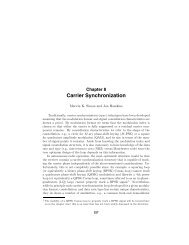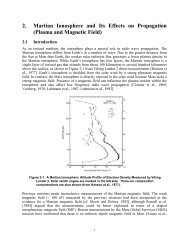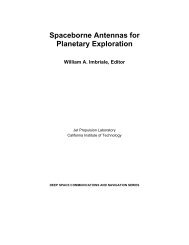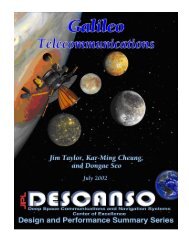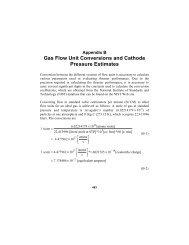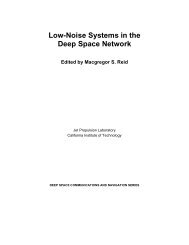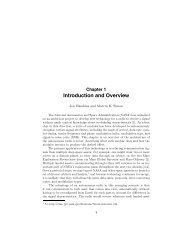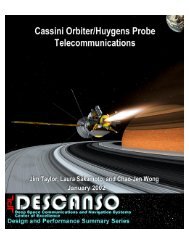Propagation Effects Handbook for Satellite Systems - DESCANSO ...
Propagation Effects Handbook for Satellite Systems - DESCANSO ...
Propagation Effects Handbook for Satellite Systems - DESCANSO ...
Create successful ePaper yourself
Turn your PDF publications into a flip-book with our unique Google optimized e-Paper software.
where D =<br />
f =<br />
s =<br />
e =<br />
apparent diameter of the sun, deg<br />
frequency, GHz<br />
power flux density, dBw/Hz-m2<br />
antenna half-power beamwidth, deg<br />
For an Earth station operating at 20 GHz with a 2 m diameter<br />
antenna (beamwidth about 0.5°) , the maximum increase in antenna<br />
temperature that would be caused by a (’tquietlt) sun transit is about<br />
8100 K, according to the <strong>for</strong>mula.<br />
The sun~s flux has been used extensively <strong>for</strong> measuring<br />
tropospheric attenuation. This is done with a sun-tracking<br />
radiometer, which monitors the noise temperature of an antenna that<br />
is devised to automatically remain pointed at the sun.<br />
6.8.7.2 Lunar Noise. The moon reflects solar radio energy back to<br />
the Earth. Its apparent size is approximately 1/2 degree in<br />
diameter, like the sun. The noise power flux density from the moon<br />
varies directly as the square of frequency, which is characteristic<br />
of radiation from a “black body.” The power flux density from the<br />
full moon is about -202 dBW/Hz-m 2<br />
at 20 GHz. The maximum antenna<br />
temperature increase due to the moon, <strong>for</strong> the 20 GHz 2m antenna<br />
considered earlier, would be only about 320K. Because of the phases<br />
of the moon and the ellipticity of its orbit, the apparent size and<br />
flux vary widely, but in a regular and predictable manner. The moon<br />
has been used in measuring Earth station G/T (Johannsen and<br />
Koury-1974).<br />
6.8.7.3 Radio Stars. The strongest radio stars are ten times<br />
weaker than the lunar emission. The strongest stars (Wait, et<br />
al-1974) emit typically -230 dBW/Hz-m2 in the 10 to 100 GHz<br />
frequency range. Three of these strong sources are Cassiopeia A,<br />
Taurus A and Orion A. These sources are sometimes utilized <strong>for</strong><br />
calibration of the ground station G/T. During the calibrations the<br />
attenuation due to the troposphere is usually cancelled out by .<br />
comparing the sky noise on the star and subtracting the adjacent<br />
(dark) sky noise.<br />
6-142<br />
.<br />
s..





